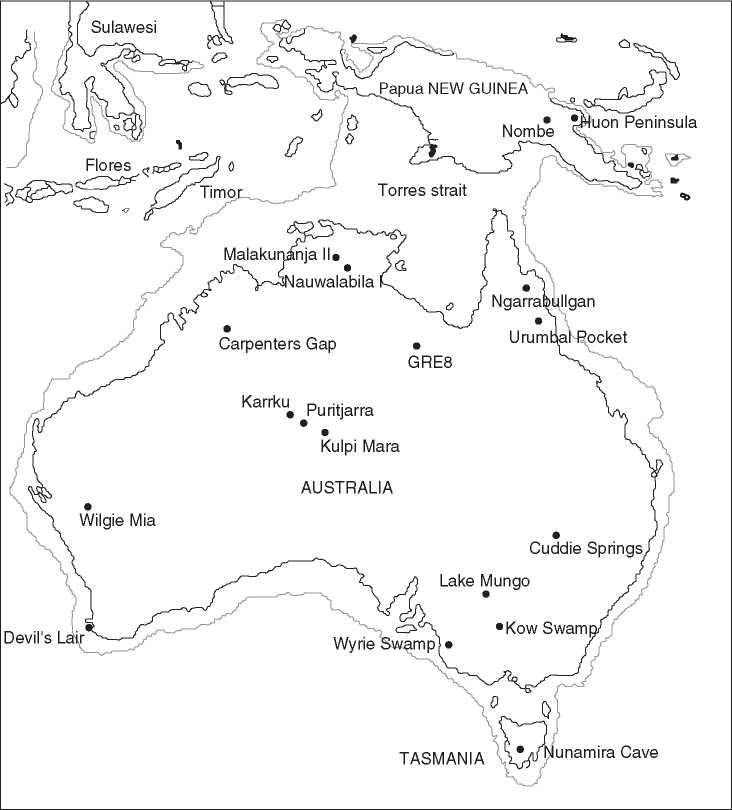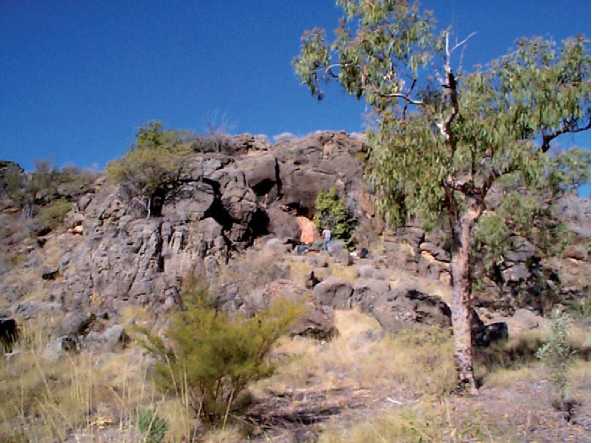Initial human colonization of the Australian continent is conservatively estimated at around 45 ka, though some researchers argue for an arrival predating this time by 10 000-15 000 years. Any archaeological sites that formed on the continental shelf, which included the Torres Strait and Bass Strait, are now submerged because of sea level rises at the terminal Pleistocene, before c. 10 ka (Figure 1). Environmental proxies such as fossil pollen (vegetation) and charcoal (fire) records have been used to support arguments for initial human colonization before

Figure 1 Map of Australia and region showing the location of sites mentioned in the text. Modern-day Australia is marked by the dark outline and the pale outline is the continental margins during the time of lowest sea level at the LGM c. 30-19 ka when Tasmania and New Guinea were joined to the mainland, together comprising Sahul.
100 ka. Fluctuations in microscopic charcoal (fire frequency) have been interpreted as indicators of a human presence, though this has not been supported by the archaeology. Landfall of the first colonizers is most likely to have been coincident with a time of lower sea levels and involved a minimum 90 km open sea crossing. As such it demonstrates a sophisticated knowledge of seafaring, language, and construction of suitable watercraft which is consistent with a maritime economy.
There are at least two colonization pathways into Australia, with most consideration given to the southern route from southeast Asia, through Java to Flores and Timor, the latter yielding archaeological evidence dating to >35 ka. There was an approximate 2000 km coastline along which people may have landed and subsequently based their coastal marine economy. A less often discussed second route, is through Halmahera,
Papua/Irian Jaya, across New Guinea and down across the Carpentarian Plain into northeastern Australia. There is good evidence for a 40 000 year occupation from the Huon Peninsula in New Guinea, and Late Pleistocene occupation of the Solomon Islands and New Ireland. Two sites dating to c. 40 ka are found in north Queensland - GRE8 (Figure 2) near the base of the Gulf of Carpentaria and Ngarrabullgan Cave (Figure 3) in the east on the Great Dividing Range that runs down the eastern coast of Australia.
The debate by archaeologists over colonization pathways continues, but whenever people arrived on the Australian continent it is clear that by the time Europeans landed here Aboriginal people occupied all environmental zones and were present in relatively large numbers, with estimations of 750 0001 000 000 at European contact. Three models were developed to account for the patterns of colonization.

Figure 2 GRE8 Rockshelter in Northern Australia where occupation deposits have been dated to c. 40 ka. The archaeological sequence is arguably continuous througH the peak period of aridity during the LGM, and may have been part of a refuge area during this time. GRE8 is located adjacent to the permanent spring-fed Gregory River in the limestone gorge country of the Riversleigh Fossil World Heritage Area. Photograph © Michael Slack.

Figure 3 Ngarrabullgan Rockshelter is located on top of Mt. Mulligan, an 18-km-long mesa surrounded by dry sclerophyll woodland. Despite <40 cm of cultural deposit, it documents an occupation sequence that extends back to around 40 ka. It was abandoned just prior to the onset of the LGM and was not reoccupied until the mid-Holocene. Photograph © Bruno David.
In 1957, Birdsell’s tri-hybrid model argued that people took somewhere between c. 1300 and 2200 years to occupy the continent. Environmental zones appear to have been no significant barrier, Birdsell arguing that carrying capacity was the rate-limiting step. Circa 1977, Bowdler proposed that the continent was occupied by traditional coastal dwellers possessing the adaptations and technology to exploit coastal and riverine environments thus defining the pathways
Of colonization. Her model was developed when little investigative work had been undertaken in the arid core. While her model is still relevant for the debate about colonization, more recent research at Puritjarra Rockshelter has demonstrated that occupation of central Australia dates to the Late Pleistocene (Figure 1). More recently, Horton has argued that the colonization of the continent was determined by the presence of freestanding water, and, as the continent dried out in the lead-up to the LGM, people moved away from the arid regions and became more concentrated in the coastal regions. As the climate improved toward the close of the Pleistocene, people started repopulating the more arid areas.
The patterns of occupation in the arid zone during the late Pleistocene have been dynamic but for the most part were probably ephemeral. In his model of arid zone occupation, Peter Veth defined three identifiable regions: ‘refuges’ or ‘islands’ where resources were relatively secure in the riverine/gorge systems and the montane uplands; ‘corridors’ - stony lowlands that would have been accessible during climatically favorable periods, but were abandoned during the Glacial Maximum; and ‘barriers’ - the large sand-ridge deserts. The latter are argued to have only been fully occupied since the terminal Pleistocene following technological and economic developments enabling access to previously sequestered resources.
Tracking the timing and patterns of colonization has depended to some degree on the use of different dating techniques. As new methods have been developed, chronologies for earlier dated sites have been discarded, reevaluated or confirmed. Radiocarbon dating of archaeological sequences has been supplemented by luminescence techniques, electron spin resonance (ESR), and Uranium series (U-series) dating. As luminescence dating became more accessible, including aliquot and single grain methods of optically stimulated luminescence (OSL), the timing of colonization of the Australian continent appeared to extend well beyond the purported 40 000 year ‘radiocarbon barrier’. The two sites that have been of importance in these discussions are Nauwalabila I and Malakunanja II, located in the north of the Northern Territory (Figure 1). Both have reported luminescence ages in excess of 50 ka, but perceived problems associated with the interpretation of all dates (radiocarbon and luminescence) from these deep sandy sequences have not seen them broadly accepted into the current datasets. In southeastern Australia, the oldest human remains (WLH3) have been recovered from the dunes of Lake Mungo (Figure 4), one of a series of lakes on the ancestral Willandra Creek system in the semi-arid zone of western New South Wales. While OSL, ESR, and U-series studies placed a minimum age of 60 ka on the male skeletal remains of WLH3, further assessment of the geomorphological and archaeological contexts has seen this estimation revised to c. 42 ka, which is consistent with other skeletal remains from this locality. Age-depth curves have been used to attribute an initial occupation age of c. 50 ka for the Lake Mungo sequences. While estimates of an early settlement of the Australian continent are tantalizing for some, these arguments must also consider how and why these early arrival dates predate the occupation sequences currently known from Southeast Asia.




 World History
World History









